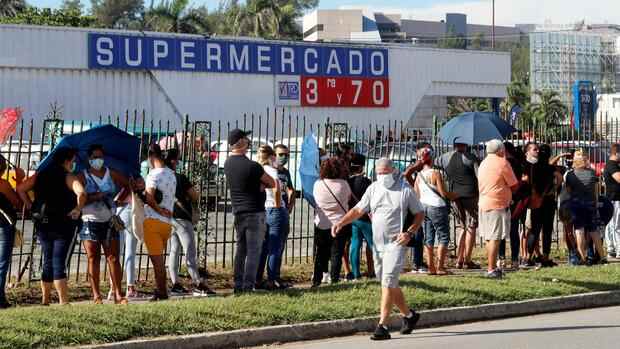Mexico City The life of the Cubans during these weeks essentially consists of waiting, hoping and forging the future – and above all standing in line. Either people are waiting in front of the embassy of a Latin American country or in front of the few grocery stores. Some hope to get a transit or entry visa for Panama, Mexico or Colombia. The others try to get hold of some rice, oil, beans or sugar for their daily meals if they are lucky.
Many of these people are united by frustration, resignation and the desire to leave the communist Caribbean island as quickly as possible. In view of the economic crisis, food shortages, inflation and new state repression, they no longer see a future for themselves in Cuba.
A year after the historic protests in July 2021, when thousands of Cubans across the country spontaneously vented their anger at mismanagement, the rigid corona lockdown, power cuts and state supervision on the streets, the situation has not improved. On the contrary: people are more frustrated, the state even more repressive.
In January, the Cuban judiciary opened criminal cases against 710 men and women involved in the protests, mainly on charges of sabotage, robbery, assault, defiance of state authority, disturbing the public peace and insulting the symbols of the fatherland.
Top jobs of the day
Find the best jobs now and
be notified by email.
A month ago, almost 400 of the accused were sentenced to draconian sentences in a mass trial and in camera. Some defendants who smashed a window a year ago now have to go to prison for twelve years, longer than a rapist, for example. Others face 25 years in prison for two days of protest.
The situation for the people of Cuba has not improved since the protests.
(Photo: dpa)
According to the local human rights organization Cubalex, at the beginning of the month around half of the protesters arrested at the time were still behind bars, with or without a trial, including several youths.
Juan Pappier of the Americas section of Human Rights Watch speaks of “the peak of oppression in Cuba, at least in this century”. “Those who don’t like the rules imposed by the regime have two options: prison or exile.”
Young people in particular are leaving the country
And so more and more people decide to turn their backs on their homeland. They often sell their homes to raise money for plane tickets and dollars for the smugglers to bring them to the United States. According to reports from migrants, around 15,000 US dollars are needed for this. The way is dangerous, whether the people actually arrive is uncertain.
Cuban economist Omar Everleny, citing data from US Customs and Border Protection (CBP) from mid-June, reports that 140,000 Cubans arrived in the US between October and Mal alone. Among them are mainly young people.
It is the largest migration movement since the so-called Mariel boat crisis in 1980, when 125,000 people wanted to go by boat to the USA from a port in western Cuba in seven months. And Everleny is certain that migration will continue.
The border protection authorities have recently registered tens of thousands of Cubans.
(Photo: Reuters)
Everleny criticizes that in addition to the continuing strong government reprisals, the economic situation has not improved either. “The indicators that led to the great dissatisfaction and protests a year ago are as bad or worse than they were then,” he says. Very high prices, power outages, a drastic loss of purchasing power – everything is worse than in 2021. In addition, the last sugar harvest was the worst in more than a century and was not even enough to cover domestic consumption.
Cuban agriculture is historically inefficient, and the government would have to import at least $1.6 billion in food annually — for which there is no money. Tourism, one of the most important sources of foreign exchange, has fallen into disuse, which is driving many small private traders to ruin. According to the Cuban Bureau of Statistics, inflation was 23.7 percent at the end of May.
A young man who took part in the protests a year ago told the Spanish newspaper El País how much the Cubans are suffering from the situation. “Back then, the power outages were just beginning; today, in the interior of the country, it’s already ten to twelve hours a day. The queues are unbearable and the supply shortages are brutal.”
Most of the population also has no access to US dollars and the only shops where you can really find essentials are in foreign exchange shops. In these shops, which were opened by the state in 2019, Cubans can buy items such as diapers or washing machines for dollars that are otherwise not available in the country.
Going shopping there is becoming more and more expensive for people. “On the street, the exchange rate is one dollar for 110 Cuban pesos,” adds the young man.
There has also been no political relief for people in recent years. The response of the government and the security forces a year ago, and above all the subsequent legal prosecution of the demonstrators, made it clear that the head of state, Miguel Díaz-Canel, who has been in office since October 2019, is no more liberal than the Castro brothers before.
More: How Russia is waging its propaganda war in Latin America
